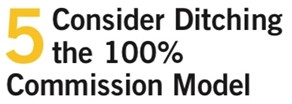Management: Considering Commissions

AlexRoz / Africa Studio / omravestudio / shutterstock.com
By now your sales force is well into sales for the second quarter of 2022 and eyeing Q3. For a lot of organizations, 2020 was a terrible sales year and 2021 brought record sales. But as 2022 began amid potentially dark economic clouds, you may not have known what to expect.
Affinity HR Group doesn’t have any crystal balls for what the future holds, but we do have some ideas about how to be best prepared to meet whatever challenges may come.

We’re assuming you don’t have a crystal ball either, so this can be a tough one. Market uncertainty, with the potential of high growth or significant decline, adds to the difficulty of setting realistic, achievable goals each quarter. If you’ve historically set goals based on previous sales (e. g. 2021 Q3 sales plus X%), it may be time to revise that process.
And just because you set goals one way at the beginning of the year doesn’t mean you can’t adjust them in times of market uncertainty. Major economic changes like recessions, account changes due to mergers and acquisitions, global instability and major weather calamities are just a few of the reasons to have a second look at sales goals. Many organizations address the issue of market uncertainty by setting six-month or even quarterly sales goals. In organizations where sales are typically short cycle, regular review and adjustment of sales goals can be particularly effective.

The most common pay mixes for sales representatives are 60% base/40% commission or 50% base/50% commission. Current high inflation rates, rising costs of housing in many metropolitan areas and the highest gas prices since 2008 may mean that base salaries are no longer competitive.
And salaries are going up. According to The Conference Board, overall wages increased faster in the third quarter of 2021 than at any other time since record keeping began. The Conference Board and Society for Human Resource Management project salary increases of 3.8%-4% for 2022. For high demand occupations in high growth areas, however, wages could increase by 6%-8% as the economy opens further and grows.
It’s not uncommon for organizations to set base salaries for sales reps and then not pay much attention to them. Now could be the time to review base salaries to stay competitive as you recruit new reps and work to retain your current sales force.

Finding customers takes time. By definition, business development is a long-term, strategic process that can focus on development of new markets and/or products. In large organizations, there are often individuals or even teams who fulfill the business development role.
In smaller organizations, however, the sales rep may be responsible for business development activities that require time commitments that lengthen or alter the sales cycle and result in less direct influence over customer buying decisions. If that’s the case in your organization, you may need to adjust your pay mix to recognize the importance of business development and the amount of time it may require.

Commission plans for sales positions can be incredibly complex. If you’ve done some research on modifying or enhancing your own plan, you’ve most likely encountered terms like tiered, ramped, hurdled, or clawback. All of these plan provisions can and do work well. Their complexity, however, requires more complicated administration and the ability of your internal systems to accurately track sales and related data.
Simple works very well, especially in smaller organizations. Two plans that are common and can be effective are the gross revenue commission model and the gross margin commission model.
The gross revenue model is constructed simply. It states that if a sales rep sells a product or service for $X, they will receive a flat percentage in commission. This model is particularly effective in organizations that seek to expand their market share or enter new markets.
The gross margin model is similar in construction. Instead of focusing on total sales, however, the focus is on profitability. Under this model, sales reps receive a flat commission percentage of the amount of a sale minus the expenses associated with that sale. For example, in an organization using a gross margin model and paying a 10% flat commission rate, a sales rep making a $10,000 sale with $4,000 of associated expenses would receive $600 (10% of gross margin/profit).

Recruiting and retaining sales reps in 2022’s extremely competitive job market is a challenge for every organization. If your pay plan is structured as a commission-only plan, expect a particularly challenging year. Consider the following:
- First year turnover in commission-only positions is often as high as 90% and competition for sales reps is fierce.
- A survey conducted by U.S. News & World Report cited Sales Rep as one of the 10 worst jobs for millennials. The top reasons? Low work-life balance and above average stress. Millennials currently make up 35% of the U.S. workforce.
- Although 100% commission plans are heavily used in insurance, real estate and other industries where one or two customer contacts yields a sale or no sale, they don’t work well in industries with long sales cycles or in organizations where significant business development activities are part of the sales role.

Palé is a contributor for Affinity HR Group, Inc., PPAI’s affiliated human resources partner, which specializes in providing human resources assistance to associations, including PPAI and its member companies. www.affinityHRgroup.com.

